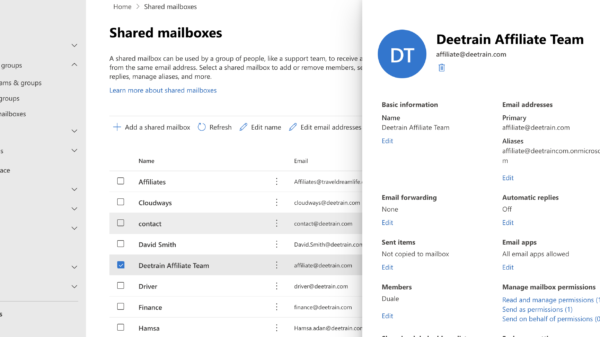When I was becoming an IT technician I was very curious about what they were actually doing on a daily basis. Even though I was studying and had multiple labs to replicate what they had, it was nowhere as near as being in a production environment. I thought this blog post will help you visualise what it is actually like and everything you need to feel confident that this role might be for you.
An IT Support Technician is responsible for all related IT technician issues including monitoring and maintaining laptops and desktops in a given organisation. You will be providing technical support for end-users across the organisation as well as providing excellent customer service.
Of course, there is much more when it comes to the actual roles and responsibilities of an IT Support technician and it varies from company to company. Some organisations tend to use different technologies than other organisations. In the following sections, I will be able to demystify the different types of roles and responsibilities of a typical IT Support technician so you can really understand and visualise exactly whats it’s like.
The Role Of An IT Support Technician
A typical day for an IT Support technician consists of various duties and responsibilities which often makes this person a jack of all trades and being able to manage multiple projects/tickets at once. Generally speaking, they are responsible for solving technical issues and usually are the first point of contact for every user that has an issue with their computers, networks, servers and the list goes on.
An example of a type of IT technician would look like this.
Meeting
When they get into the office or working from home on a typical Monday morning they would join their team meeting. This would usually consist of their line manager and their colleagues. The reason for the meeting is to discuss what they are working for on that day or week and find out all of the pain points or difficulties they are facing with their day (error messages, unable to solve tickets). This would also be a time for their line manager to task them with anything urgent projects or tickets they would need to solve for that day or week.
Ticketing System
Once the meeting has concluded, they would directly login into the ticketing system (Zendesk, ServiceNow). This is where they would see all of the ‘tickets’ that have been submitted by end-users or customers that have technical issues to be resolved.
An agent would see the ticket in the queue and assign the ticket to themself. They would then liaise with the user to find out more about the issue alongside screenshots or anything helpful to solve the ticket.
Ticketing systems are very helpful when tracking and managing issues. The user will navigate to the ticketing system and log their issue. When they have ‘raised their ticket’ an agent within that team (ServiceDesk team) would pick up the ticket and communicate with them until the issue is resolved.
A ticketing system is a software package that managers a list of issues that we can manage and track.
Answer Tickets
Once they have logged into the ticketing system app, this would be a good time to start answers all of the tickets that are assigned to them. If they have 10 tickets, this would be a good time for them to respond to all 10 and solve as much as possible. Sometimes it takes a bit of time for the user to contact them back so it is always good to respond as soon as possible.
Create and manage users
Some of the tickets that are assigned to the user may include a new starter joining the business. Now, depending on the technologies the company is using, creating the user and assigning the necessary groups may differ. Let’s just say we are using Active Directory in this case. They would log in to the server and create the user.
Reset Passwords
Resetting passwords is very common when working as an IT Support technician. You would be surprised the number of times users put in the wrong password or when they come back from holiday and they forget their passwords. Password resets are a big one so it is good to learn it while you can. I have created a resource for you on how you can reset a users password in Active directory and how to unlock them in case they put in the wrong password multiple times.
Roles and responsibilities
Now, the roles and responsibilities differ from company to company as discussed earlier. But it is worth noting that ALL IT Support technicians bear the same responsibility by providing excellent customer service and support end-users with technical problems and issues. The below list demonstrates the responsibilities of a technician as a whole across most technologies.
- Excellent customer service to end-users
- Creating helpful guides for end users they can troubleshoot issues on their own easily
- Supporting Windows 10 & macOS devices
- Answering tickets and regularly in contact with the users on the progress of the ticket
- Providing meeting support in person or remotely
- Using Remote support tools to support users in any location.
- Staying focused and organised in a fast-paced environment
- Help improved processes and procedures by sharing actions that can be automated
- Create and maintain documentation for both end-users and tech staff
As you can see that some of these responsibilities are crucial for every potential IT Support technician. Soft skills are also necessary when dealing with end-users. Understanding these exact requirements is crucial when you’re trying to succeed as an IT technician.
Supporting users
Supporting users is the bread and butter of the job. Making sure that you answer every single ticket and ensuring that the issue has been resolved or escalated to the correct team is the main priority. As stated before, providing excellent service to the user is a big part of the job and just making the user feel that you are there to help and guide them.
Learning New Skills
In IT you will always be faced with new technologies constantly coming out and changes being made. This requires updating your current skills by taking various courses. The good thing is you have an ocean of IT courses that you can take online. Depending on what technologies you’re supporting in your environment, it would be wise to learn and increase your skills on them.
Learning on the job
Nothing beats experience. The more you learn at your organisations the better you become in the future. Most organisations have a wiki or a documentation section on their local intranet. This would mean if you have front-row seat in how your infrastructure environment is set up. Usually, the system administrators and network engineers work together to document their design and you can learn how they built the systems and even try to replicate it in your home lab.
Leveraging other departments
Another learning opportunity is leveraging other departments. When you work in IT you will have access to the Software, Network, cloud engineering teams (and usually providing technical support for these teams!). This is an excellent opportunity to speak with them or even shadow them in what they do. They can even guide you in how to land a job in their field or even train you personally.
Wrapping up
This blog post has now given you an insight into what an IT Support technician actually do alongside all of the most important skills that you would need to succeed in this career. We have also provided some of the technologies we use on a daily basis to support our users.









